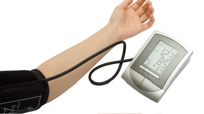News
The latest news on this change — carefully culled from the world wide web by our change agents. They do the surfing, so you don't have to!
Need a BP Check? Do It Yourself!

If you’re one of millions of Americans with high blood pressure, experts recommend that you check your blood pressure regularly at home to help monitor and control your health condition. With monitors less than $100, those at risk have no excuse not to.
One of the reasons experts recommend regularly checking your blood pressure at home is because many people’s blood pressure levels are elevated at the doctor’s office. Dubbed “the white coat effect,” many people feel anxious or under pressure when they are at a doctor’s office and a medical professional is “testing” them. Blood pressure levels are more likely to be more accurate at home where people can check their own blood pressure in a comfortable environment.
Guidelines for home monitoring of your blood pressure include:
* Patients should buy a monitor with cuffs that fit on the upper arm. They should use a proper fitting cuff, and ask a healthcare provider the proper way to use the monitors.
* Wrist monitors are NOT recommended.
* Patients should take two or three readings at a time, one minute apart, while resting in a seated position. The arm should be supported, with the upper arm at heart level, and feet on the floor (back supported, legs uncrossed). It's important to take the readings at the same time each day, such as morning and evening, or as a healthcare professional recommends.
* Use of a home monitor can confirm suspected or newly diagnosed hypertension and rule out diagnosis for patients whose readings at the doctor's office don't reflect their actual pressures over time.
* The target goal for treatment with a home monitor is less than 135/85 mm Hg, or less than 130/80 in high-risk patients.
What helps you keep your high blood pressure in check? [Science Daily]







